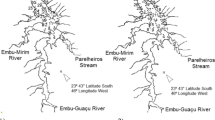Conclusions
Studies conducted on reservoirs and lakes located in mercury-rich provinces of Central Asia, Caucasia, Siberia, and Gorno Altay have indicated that the ecological setting in these regions adds up rather favorably when there is no significant technogenic pollution. The water bodies are characterized by satisfactory water quality.
Based on mercury levels in various components of the natural environment, the lands under consideration are close to regions that have not been polluted by man. At the same time, the characteristic features of their metallogenesis dictate a somewhat elevated content of a number of metals in the soil, vegetation, waters, and bodies of bioindicators as compared with standard levels and the characteristics of regions not polluted by man.
Lakes and reservoirs play the role of geochemical barrier for compounds of mercury and other metals. A reduction in their concentration in the water occurs primarily due to the sedimentation of suspended matter and sorption of dissolved compounds by bottom sediments.
Suspended matter and high-molecular-weight complexes with a natural organic substance are basic forms of migration of heavy metals in the surface waters of the regions under consideration. The bioaccessibility of these forms is reduced. As a result, the level of accumulation of toxic elements in fish is low.
The indicated bodies of water have been used for many years by people for purposes of water supply, irrigation, recreation, and fishing. Here, no negative effect of the geochemical setting on people's health has been noted.
The laws that have been established enable us to conclude that the natural elevated polymetallic background of an area with no significant technogenic pollution is not an ecological contraindication for hydraulic construction.
Similar content being viewed by others
References
Behavior of Mercury and Other Heavy Metals in Ecosystems [in Russian], Sibirskoe Otdelenie Akademii Nauk SSSR, Novosibirsk (1989).
J. Muir and S. Ramamurti,Heavy Metals in Natural Waters [Russian translation], Mir, Moscow (1987).
I. L. Dmitrieva, V. S. Boldenkov, O. N. Leonova, and G. V. Motuzova, Mercury in the natural environment of the construction region surrounding the Katun' hydroelectric plant with controlled regulation,Collection of Works of the Gidroproekt [in Russian], No. 144 (1990).
S. O. Rozhdestvenskaya, L. K. Sadovnikova, and G. N. Vasilenko, Some characteristic features of the effect of the Akatashsk mercury deposit and combine on the surrounding natural environment,Collection of Works of the Gidroproekt [in Russian], No. 144 (1990).
Review of the Background State of the Natural Environment in the USSR [in Russian], Gidrometeoizdat, Moscow (1987).
F. L. Saupe, “La geologie du disement de mercure d'Almaden (Province de Ciudai Real, Eshagne)”,Sci. De la Terre, Memoire,29 (1973).
Additional information
Translated from Gidrotekhnicheskoe Stroitel'stvo, No. 10, pp. 33–38, October, 1998.
Rights and permissions
About this article
Cite this article
Dmitrieva, I.L. Effect of the natural polymetallic background on the ecological setting and water quality of lakes and reservoirs. Hydrotechnical Construction 32, 625–632 (1998). https://doi.org/10.1007/BF02446339
Issue Date:
DOI: https://doi.org/10.1007/BF02446339




